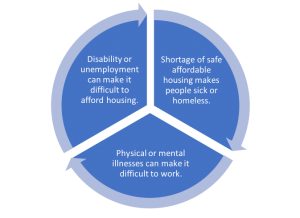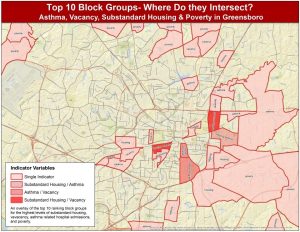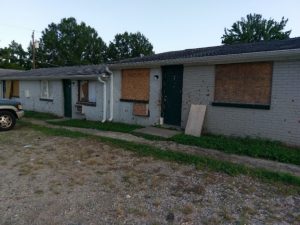
How can housing, health, and employment build a healthy economy?
What happens when housing declines?
How can we engage our community in re-building a healthy economy?
I’m glad to show the positive connections between safe and affordable housing and benefits to the community and individuals of a stronger local economy and healthier people. As the graphic above shows, what we sometimes think of as separate things – jobs and economic activity, or asthma and health care – actually link back to housing.
Here’s what I see in Greensboro – I’m eager to hear how other communities are working on similar kinds of engagement of residents, citizens, health care people, and university resources.
- Improvements in housing, health, and economy can build upon each other in an upward progression
Housing is an economic issue: Ramping up the skilled construction workforce to build and rehabilitate housing strengthens our economic capacity. Expanding the number of affordable houses and apartments throughout Greensboro puts people closer to their jobs, including essential wage-earners relying on public transportation. Designing new types of housing—at the right price—allows recent graduates and entrepreneurs to build careers and businesses here. Investing broadens the tax base.
Housing is a health issue: Restoring housing to safe and healthy conditions reduces sick days and cuts costs for medical treatment. Aligning health and community development has put Greensboro in the forefront of national attention (which I’ll describe below).
Health is an economic issue: Providing health care is a significant sector of our economy. With health care transformation from treating serious illness to promoting wellness, health sector employment will broaden. Preventing injuries and illnesses keeps workers on the job, so that the “sandwich generation” doesn’t need to call in sick after rushing a child to the hospital or finding a frail parent on the floor after a fall.
And our economy is a housing and health issue: Earning steady income allows workers and entrepreneurs more choices for good places to live. Matching workforce skills to employment opportunities, especially in construction where there is a shortage of skilled workers, can simultaneously prevent delays in residential development and raise household income.
- When parts of this triangle are missing, like the “persistent shortage of housing,” the cycle spirals downward, eroding our economy and damaging health
When the only available housing costs more than half of the household income, tenants are frequently on the verge of eviction and homeowners are at risk of foreclosure and subsequent homelessness.

When the housing is in dangerous condition, residents are at risk of injury and illness, posing barriers to employment—further limiting access to good places to live.
Substandard and vacant housing, in turn, contribute to decline of surrounding property values and public health. This depresses the economy, shrinks the housing inventory, and sends people to the hospital.
The Center for Housing and Community Studies at University of North Carolina at Greensboro did a meticulous inventory of housing conditions throughout Greensboro. They compared housing data with asthma hospital visits and census data to create this map showing the intersection of asthma, vacancy, substandard housing, and poverty.

The negative cycle of shortage of safe housing, health disparities, and economic decline is evident in the concentrations of problems.
- Broad-based collaboration can turn around the downward spiral
Greensboro is one of 50 US cities awarded an InvestHealth grant from Robert Wood Johnson Foundation to change health outcomes through investment in buildings. The team—City of Greensboro, UNCG, Cone Health, East Greensboro Now, Greensboro Housing Coalition—is completing the business plan for how to systematically repair deteriorating housing that triggers asthma attacks.
After mapping the intersections of hospital visits for respiratory illnesses, the team identified Health Impact Communities for where to focus housing interventions, while working on system changes that can achieve broad improvements and sustainability.
University students have been trained to reach out to households in Health Impact Communities to offer information about health and housing resources, in partnership with neighborhood associations. Healthy home specialists assess the health risks in the home, educate residents about the ways they can reduce asthma triggers in their homes and about their own responsibilities for home maintenance, and help them navigate the resources available for home repairs. Most of the asthma triggers are housing code violations that must, by law, be corrected: water leaks, heating/ventilation, holes that let in rats and cockroaches.
Next is exploring opportunities for residents of Health Impact Communities to be trained in construction skills to do minor repairs that remediate the unhealthy housing conditions. The team is assembling information about all the opportunities for investing public and private dollars in the repairs to improve respiratory health while preserving property values for homeowners and rental owners.

Greensboro is one of just 19 communities nationwide awarded a BUILD Health Challenge grant from a consortium of national funders, including Robert Wood Johnson, The Kresge Foundation, Kellogg, and BCBSNC Foundation. “BUILD” combines Bold action to change policies with Upstream strategies that Integrate clinical and community health in a Local neighborhood (Cottage Grove), using Data to measure outcomes.
Collaborative Cottage Grove is engaging community residents in shared leadership of action to improve housing conditions, increase access to fresh food, and work with the city to make safer places to walk and play outdoors. Community members and medical allies successfully advocated for Greensboro’s Minimum Housing Commission to order that code violations in Avalon Trace Apartments be repaired in 90 days or the city would have the authority to repair and place a first-position lien on the property for repair costs. This prompted the owners to offer the apartments for sale, creating an opportunity for rehabilitation by a new owner after decades of decline.
Purchase/rehab to healthy conditions is an excellent “mission fit” for investment funders seeking health outcomes. This catalytic investment will revitalize a Health Impact Community and demonstrate the potential of community engagement to build a healthy economy.